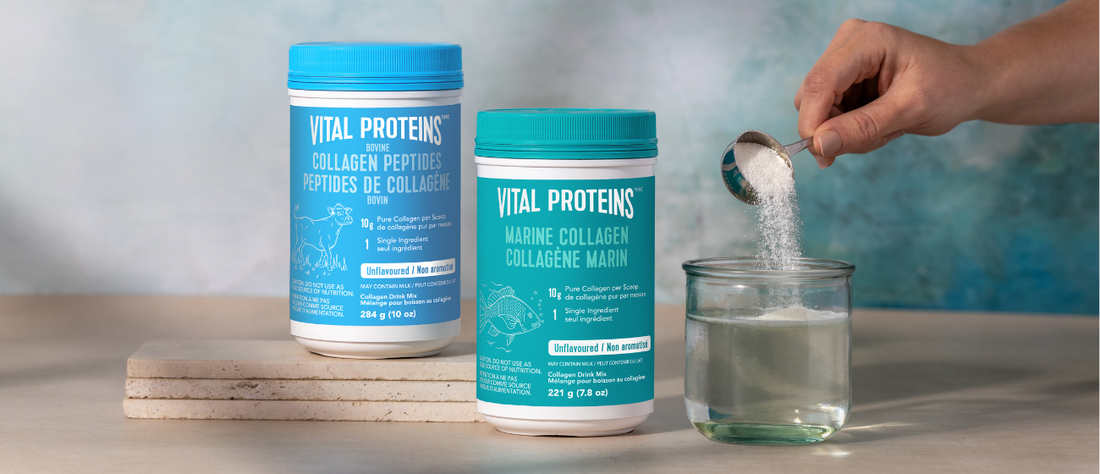
WHAT ARE THE DIFFERENT SOURCES AND TYPES OF COLLAGEN?
Share
WHERE DOES COLLAGEN COME FROM AND HOW IS IT MADE?
As a naturally occurring protein, collagen is always derived from animal sources. Collagen supplements are generally produced by extracting collagen proteins from animal tissue such as beef, chicken and fish. The majority of collagen extracted today comes from bovine (cow) bones.
-
BOVINE (COW) COLLAGEN
One of the most common sources of collagen peptides comes from cows. Typically obtained from the hide, bone, and tendons of the animal, it’s commonly referred to as bovine collagen. Bovine collagen is rich in types I and III collagen.
-
MARINE (FISH) COLLAGEN
Marine collagen has the same benefits as collagen sourced from cows or other land animals. Made from one simple ingredient, Vital Proteins® Marine Collagen is sourced from the scales of Non-GMO Project Verified, wild-caught white fish off the coast of Alaska. The latter is a favorite among those following a Pescatarian-friendly diet and will offer similar benefits as collagen peptides from land animals.
-
POULTRY (CHICKEN) COLLAGEN
,p>Poultry collagen is primarily derived from the breast bones of chickens, but it may also be obtained from the skins of chickens. Chicken collagen is predominantly type I collagen, which is most abundant in the joints of the body. It also contains components such as chondroitin and glycosaminoglycans (GAGs), which the body uses to make cartilage tissue that cushions the joints. Chicken collagen also contains high levels of proline and glycine - both of which are important building blocks of collagen.
ARE THERE DIFFERENT TYPES OF COLLAGEN?
There are many types of collagen throughout the body; more than 25 distinct types, in fact. While they all share the same physical structure, the differences between these collagen proteins range from slight variations in protein subunits to broad differences in the primary peptide sequences.
Types I-IV are the most prevalent collagen proteins, found in bones, skin, and vessels (Type I), cartilage (Type II), ligaments (Type III), and structural networks (i.e. extracellular matrix, basement membrane) in organs (Type IV). Across all types of collagen glycine, proline, and hydroxyproline are the most abundant amino acids.
-
TYPE I COLLAGEN
Type I is the most prevalent type of collagen in the human body. This is the type of collagen you're probably thinking about if you’re interested in preserving the levels of collagen in your skin, hair or nails. Because it is so prevalent in the connective tissues, the decrease of type I collagen often results in characteristics such as sagging skin, fine lines, brittle nails and thinning hair. But type I collagen isn’t just a beauty-related substance. It’s also a major component of the tendons, blood vessels, organs and bones.
-
TYPE II COLLAGEN
Though somewhat less prevalent in the body than type I, type II collagen is extremely important. It is the main component of cartilage and plays an important role in joint function. In fact, collagen has been found to help reduce joint pain associated with osteoarthritis.
-
TYPE III COLLAGEN
The third common type of collagen, Type III, is generally found in reticular fibers, such as in the bone marrow. Usually found alongside Type I collagen, it forms a mesh-like network that acts as support for soft tissue in organs.
